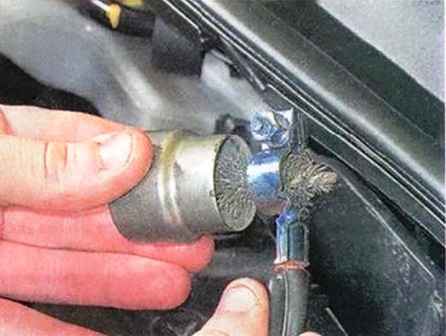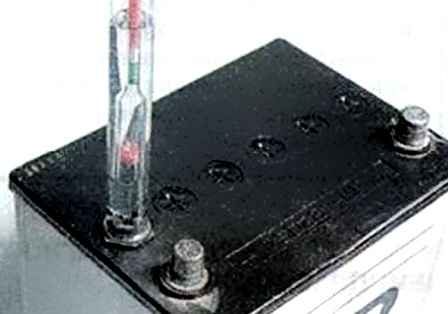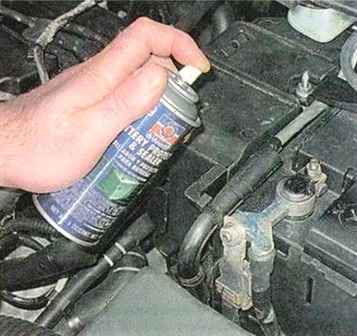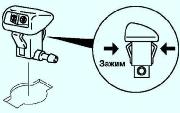Preparing the car
Wipe the top of the battery with a cloth dampened with a 10% solution of baking soda or ammonia, and then clean water
By the color of the built-in charge level indicator (if installed in the battery), we check the battery status:
- - green (battery good);
- - black (battery needs to be charged);
- - white (low electrolyte level). The malfunction may be caused by improper charging of the battery or a malfunction of the voltage regulator
After eliminating the cause of the low electrolyte level, the battery should be replaced if there are difficulties in operating the car
Check the reliability of fastening the battery to the car, if necessary, tighten the nuts securing the pressure plate
Check the condition of the battery terminals. If they are covered with a layer of oxides, remove the terminals from the battery terminals.

We clean the battery leads with a special tool

Checking the condition of the power wire terminals.
If they are covered with a layer of oxides, we clean the inner surfaces of the terminals to a shine, apply conductive grease and install the terminals in place
Checking and charging the battery
The built-in indicator gives a rough estimate of the battery condition, so it is necessary to periodically check the battery using special devices
For an approximate assessment of the battery charge (in the absence of a hydrometer), we measure the voltage at its terminals and compare it with the data in the table (values \u200b\u200bare given at a temperature of 20-24 º C.).
| Battery terminal voltage, V | Charge, % |
|---|---|
| 12.6 | 100 |
| 12.4 | 75 |
| 12,2 | 50 |
| 12.0 | 25 |
If the battery is less than 50% charged, it needs to be charged
If you have a hydrometer, you can check the battery more accurately

To do this, unscrew the plugs of the battery cans with a screwdriver

We prepare the hydrometer for work and measure the electrolyte density in each battery bank

Compare the received values with the given values
The resulting values must be inside the "A" zone
If the readings are lower, the battery needs to be charged
If higher, the battery is overcharging, most likely caused by a faulty voltage regulator
If necessary, remove the battery from the car or disconnect the wire terminals from the battery terminals
To perform charging, we connect the charger to the battery terminals, observing the polarity, and only after that we turn on the charger in the mains
Charging current not up to must exceed 10% of the battery capacity in amps, i.e. for a battery with a capacity of 55 Ah, the maximum charging current must be 5.5 A.
Charging the battery.
The process is controlled by periodically checking the degree of charge. Charging time for a fully discharged battery is at least ten hours at maximum charging current
We stop charging the battery after it is fully charged: first, disconnect the charger from the mains and only then disconnect the wires from the battery terminals
We twist the plugs of the battery cans, put the terminals of the power wires on the battery terminals

We tighten the nuts of the clamping bolts for fastening the terminals and apply a protective sealant to the terminals and battery terminals.
Such a sealant is more reliable than conventional grease, it protects battery terminals and terminals from corrosion.











